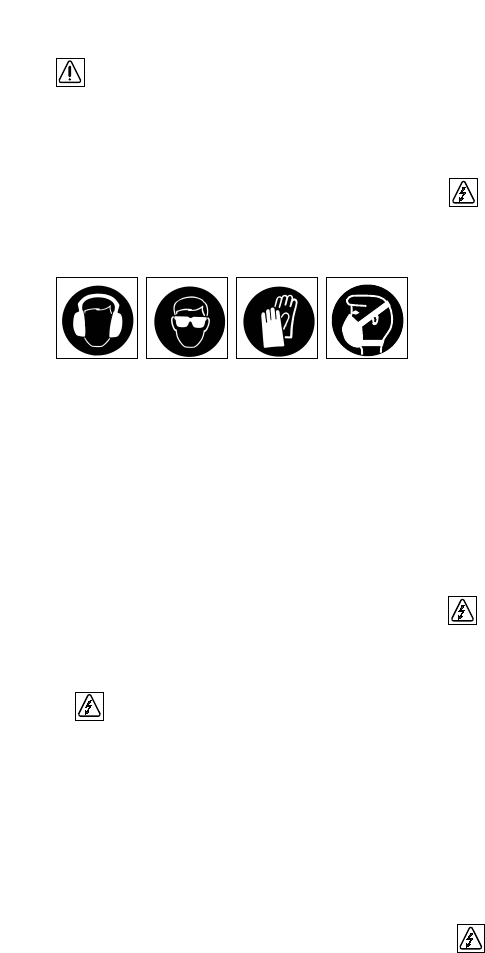
11
Safety precautions
When using electric tools, the following fundamental
safety precautions must always be observed in order to
avoid the risk of injury, electric shock and fire hazards.
Please read and observe the instructions below before
using the tool.
1. Use protective equipment.
2. Wear suitable working clothing.
Don’t wear loose clothing, loose long hair or jewellery
as it can become caught up in moving parts of the elec-
tric tool. Wear non-slip shoes.
3. Make the working area safe.
Objects which could cause injury should be removed
from the working area. Ensure that the area is well lit.
When working, keep other persons outside the range of
the tool you are using.
4. Take the influences of the surrounding area into
account.
Don’t expose the tool to rain or snow and don’t operate
it in the vicinity of flammable liquids or gases.
5. Check the tool each time before use.
Check the condition of the tool, the supply cord and
mains plug. Don’t use it if it is damaged, incomplete or
if the controls cannot be operated correctly. Before fur-
ther use of the tool, a guard or other part that is dam-
aged should be carefully checked to determine that it
will operate properly and perform its intended function.
Check for alignment or moving parts, free running of
moving parts, breakage of parts, mounting and any oth-
er conditions that may affect its operation. A guard or
other part that is damaged should be properly repaired
or replaced by an authorized service centre unless oth-
erwise indicated in this instruction manual. Have defec-
tive switches replaced by an authorized service facility.
Do not use the tool if the switch does not turn it on and
off.
6. Use the correct insert tool.
Ensure that the insert tools (saw blades etc.) are equipped
with the appropriate connection end to fit the blade holder
on the electric tool and that they are clamped in posi-
tion correctly in the blade holder.
Use only the recommended original Hilti accessories
and auxiliary equipment.
7. Use the tool only for the purposes for which it is
intended.
Do not force small tools or attachments to do the job of
a heavy duty tool. Do not use tools for purposes not
intended; for example, do not use circular saws to cut
tree limbs or logs.
8. Apply a safe working method.
Avoid unfavourable body positions. Always ensure you
have a safe stance. Always hold the tool in both hands
when it is in use ẅ. To ensure optimum efficiency and
safety when working, the contact shoe of the tool must
always be pressed against the workpiece Ẇ.
Always use saw blades of adequate length. To avoid kick-
back, the end of the blade must always project at least
40 mm beyond the workpiece throughout the entire
stroke ẇ. It will do the job better and safer at he rate for
which it was intended.
The blade may become stuck unexpectedly. Switch off
the tool if your attention is distracted from your work.
When the tool is in use, always guide the supply cord
away from the tool to the rear.
Never carry the tool by the supply cord. Don’t unplug
the tool by pulling on the supply cord. Don’t expose the
supply cord to heat, oil or sharp edges. If the supply
cord becomes damaged while working, don’t touch it -
unplug the mains plug immediately.
Never place your fingers or a hand in front of the saw
blade when working with the saw.
9. Take care to avoid concealed cables and pipes.
Concealed electric cables or gas and water pipes pre-
sent a serious hazard if damaged while you are work-
ing. Accordingly, check the area in which you are work-
ing beforehand (e.g. using a metal detector). Avoid con-
tact between your body and earthed / grounded objects
such as pipes or radiators. External metal parts of the
tool may become live, for example, when an electric
cable is cut into inadvertently.
10. Avoid unintentional starting.
Don’t carry the tool with your finger on the control switch
while it is connected to the mains supply. Check that the
tool is switched off before connecting it to the mains
supply. Pull the plug out of the mains socket when the
tool is not in use, e.g. during pauses between work,
before maintenance and when changing insert tools.
11. Keep the electric tool and insert tools in good
condition.
Follow the care and maintenance instructions and replace
insert tools in good time. Never operate the tool when
it is dirty or wet. When not in use, tools should be stored
in a dry, high or locked-up place, out of reach of chil-
dren. Dust or dampness on the surface of the tool make
it slippery and difficult to hold and may, under unfavourable
conditions, present a risk of electric shock.
Repairs to the tool may be carried out only by an autho-
rised electrical specialist using original Hilti spare parts.
Wear ear
protection
Wear goggles Wear protective
gloves
Wear respiratory
protection when
the work causes
dust















